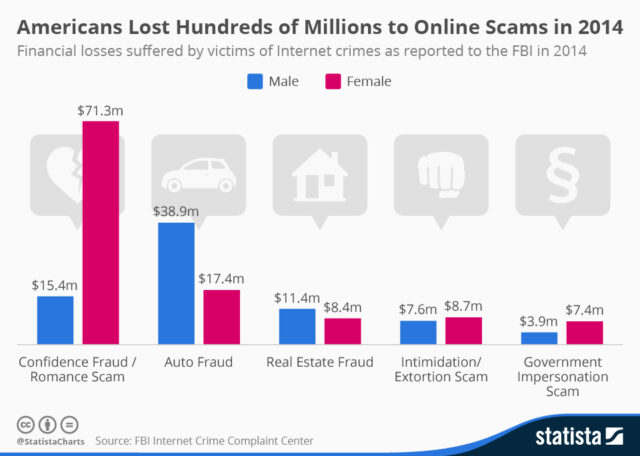
Based on FTC data, Americans lost a whopping $8.8 billion to scams last year. From phishing emails, IRS impersonations, and fake lotteries to charity scams and romance fraud, there is no end to the types of swindles you can encounter today, both in the digital space and the real world.
But why do Americans increasingly fall victim to them despite continuous warnings? And how can you protect your financial wealth and ensure personal safety from malicious actors? Let’s explore.
The Real Reasons Americans Are Losing Money to Scams
Several factors contribute to a surge in fraudulent advances and the increasing losses consumers experience due to fraud.

Growing dependency on digital services
The most significant factor is undoubtedly the rising digital interactions as more people transition to cyberspace for shopping, banking, socializing, entertainment, and countless other daily activities that previously involved physical engagement.
This has exposed individuals of all ages to a new digital realm, which certain segments of society, especially the older generations, are largely unfamiliar with. Younger ones, on the other hand, are more internet savvy. However, their limited life experiences make them just as vulnerable to scams as older adults.
Emotional manipulations
The trusting nature of senior citizens makes them extra susceptible to deceptive schemes.
However, it is important to note that anyone can become a victim, despite their age, race, education, or wealth. This is because all humans can be gullible given the right emotional triggers, may it be fear, greed, or empathy.
Technological developments
The internet and advanced technology, such as artificial intelligence and deep fake, have also provided new-found ammunition for scammers to mask their identities, hunt for victims, and launch new kinds of frauds never seen before. As a result, ordinary citizens are losing money in ways they could have hardly imagined just a few decades back.
Insufficient knowledge
Lack of awareness and understanding of common scams, their warning signs, and measures to avoid or mitigate threats is a major reason for more people experiencing fraud. Remember, the less knowledge you have, the more vulnerable you remain.
Having said that, ignorance is just as prevalent. When you believe you will never fall for a swindle, you are likelier to ignore warnings, dismiss precautionary steps, and disregard obvious red flags.
How Can You Protect Yourself From Scams?
Despite the mounting concerns, you can minimize fraudulent threats to a large extent by adopting certain preventative measures. Knowing how to tackle deceptive advances is equally crucial for mitigating damage and avoiding financial losses.

Build awareness
Fraud can emerge in a variety of ways, and some may even display specific patterns. For instance, IRS scams are particularly prevalent during the tax filing season, while charity fraud is widespread in times of natural disasters.
Understanding the diverse nature of scam attempts, their changing trends, and key warning signs is the first step to bolstering your security defenses.
To detect fraud, watch out for the following red flags:
- Pressure to act fast. It can include limited-time offers and urgent requests for donations or payments.
- Unusual or unexpected communications asking for personal information or money.
- Payment requirements involving hard-to-trace options, including wire transfers, gift cards, and cryptocurrency.
- Too-good-to-be-real deals such as products with steep discounts, investments offering unusually high returns, and medicines that promise miracle cures.
- Communications with obvious typos, grammatical errors, and generic greetings.
Take preventative action
The old adage “prevention is better than cure” holds true when combating fraud as well.
Here are the essential steps you must take:
- Practice caution when dealing with an unsolicited call, email, SMS, or social media message, whether from a telemarketer, insurance salesman, charity, bank, the IRS, or anyone else.
- Authenticate such communications before you respond. For example, search unfamiliar contact numbers on PhoneHistory to identify whom they belong to. And if someone you know reaches out using a number you don’t recognize, call them back on their regular phone number to ensure it is not an impersonation.
- Never respond to any solicitation for money or personal information before you check its legitimacy.
- Avoid clicking links, even when you receive them from friends and family. If you need to visit a specific website, find it on a search engine instead of using unsolicited links.
- Limit voluntary sharing of personal information that could make you a target for scams. For instance, assess what you post on social media and avoid memberships, newsletters, and free giveaways that request identifiable data.
- Protect your devices from virus attacks. Install anti-virus protection that can scan devices, files, emails, websites, and downloads. Also, avoid unverified attachments, third-party apps, and software.
- Prevent data tracking by legitimate businesses to minimize data threats arising from third-party breaches and leaks. Turn off data collecting and sharing features on websites, block cookies, delete your search history on browsers, and remove apps that request access to personal data.
- Regularly check your bank and credit card transactions, credit reports, and statements issued by critical service providers, including your medical insurer.

Learn how to mitigate damage
Some scam threats are unavoidable. If you find out you have become a victim of one, acting fast is imperative to minimize damage.
- Inform your bank and credit card issuer if your financial details are compromised or when you have unwittingly approved a transaction to a fraudster. Depending on the incident, your financial institution could prevent further money outflow by freezing the account. They may also attempt to reverse the payment.
- When you experience an impersonation scam, inform the relevant organization or individual the scammers have mimicked.
- If your email, social media accounts, or phone number is compromised, alert your friends, family, coworkers, and the relevant service provider.
- When a personal account is breached, change all your login credentials, even on unrelated accounts.
- Gather evidence and submit a complaint to law enforcement and the Federal Trade Commission.
- Monitor your financial and other personal accounts to identify further fraudulent activities.
Key Takeaways
With little signs of frauds and scams slowing down, Americans continue to lose billions of dollars to deceptive schemes each year.
A growing reliance on digital services, emotional manipulation tactics that prove disturbingly effective, technological developments that provide ammunition for scammers, and a dire lack of knowledge on the part of ordinary citizens all contribute to this trend.
So, take proactive steps to build awareness and identify common fraud. Take preventative measures and learn how you could mitigate losses in the event you fall victim.









